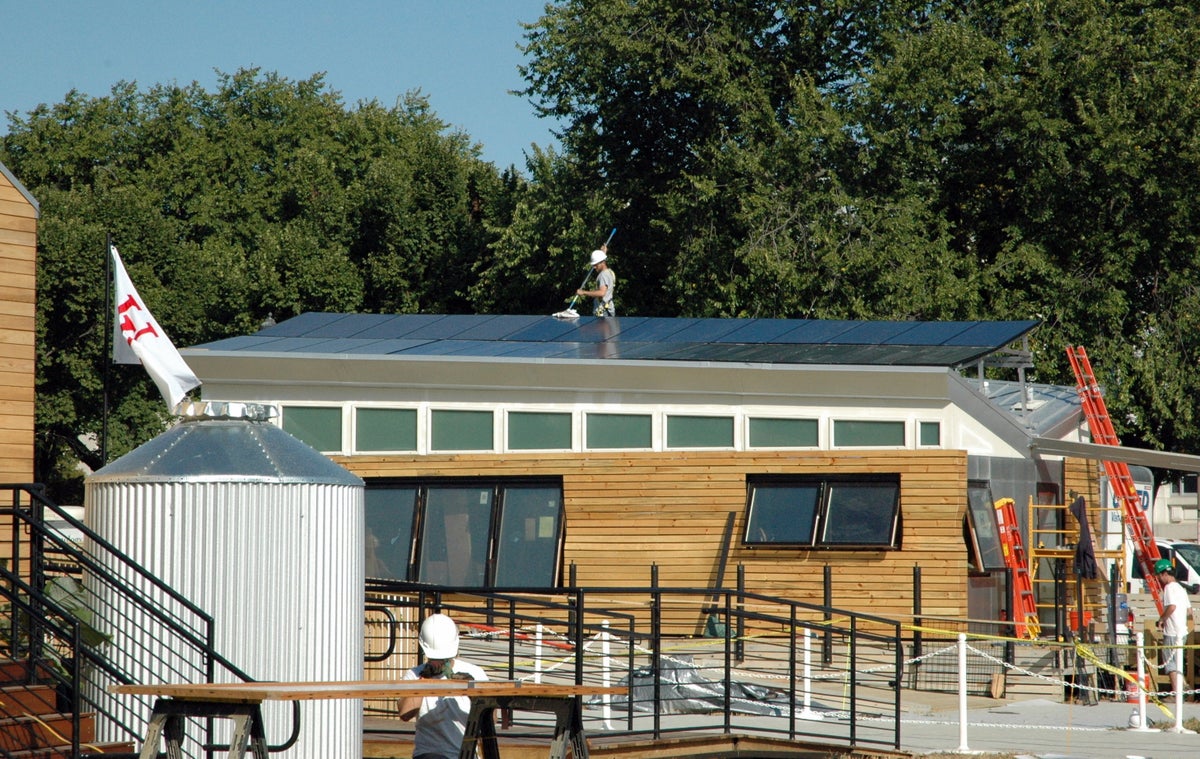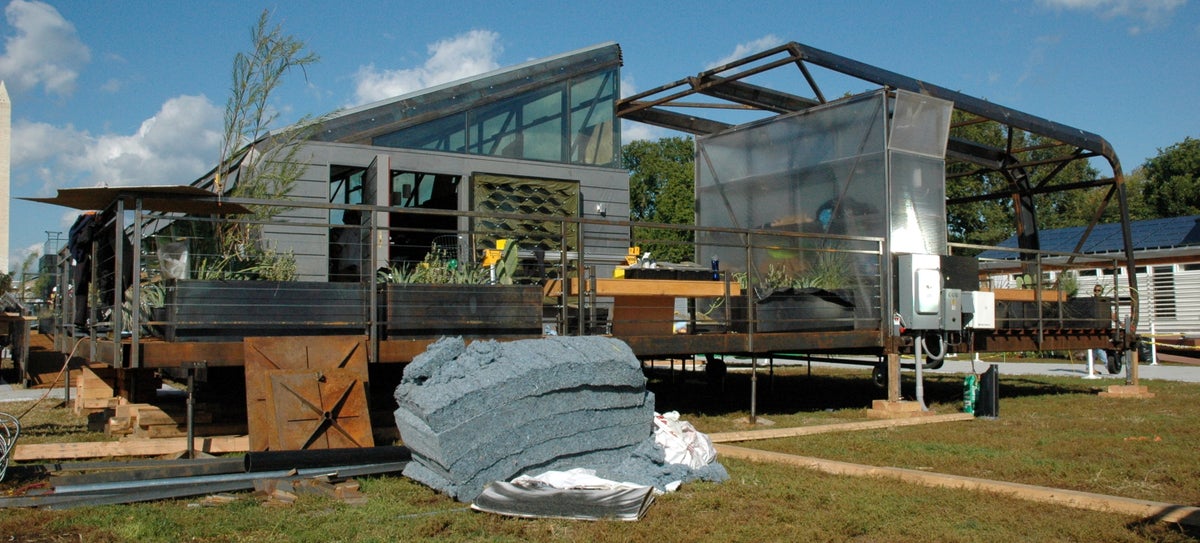Photos: Solar homes take root at Solar Decathlon
<p>Student competitors frantically try to finish building powered only by solar energy for the Solar Decathlon this week in Washington, D.C. </p>

Team Wisconsin
It's time to spiff up the solar panels. The Solar Decathlon competition is poised to begin this week in Washington, D.C., where student teams from 20 colleges from the U.S., Canada, Europe, and Puerto Rico design and build homes that operate on solar power only. Energy Secretary Steven Chu is scheduled to speak at the opening ceremony on Thursday and the houses will be open to the public for 10 days starting on Friday.
Here a student from Team Wisconsin cleans up the solar panels, while a student on the left from Team Louisiana finishes work on their building. In general, the size of the solar arrays on these houses is bigger than what a typical U.S. home needs because the panels need to run the homes for 10 days and the teams are judged on how much excess electricity they can generate. Those solar panels make the homes expensive--many of the houses cost more than $500,000.
Team California goes for good looks
Two years ago, the team from Santa Clara University was considered a long shot but managed to get third place in the Solar Decathlon, beating out teams with bigger budgets and more experience in the competition. This year, Santa Clara University teamed with the California College of the Arts in San Francisco to improve on the architecture. Although the home is just 800 square feet, it's subdivided into four different sections and has a large deck to give it a bigger feel. Being from the Bay Area, they've pushed the high-tech to limit. They tied together different building-automation systems so that a person can control lighting, windows and shades, heating and cooling, and electrical appliances from a touch screen or an iPhone application.
Control central
California is certainly not the only team that has home energy monitors and controls. Here a member from Team Germany, the winner of the competition two years ago, checks the home automation system.
Team Germany
In the Solar Decathlon two years ago, Team Germany from Technische Universtat Darmstadt used louvers that had solar cells integrated onto them. This year's designers have taken building-integrated photovoltaics to a new level. They designed clapboard siding with solar cells fitted onto aluminum strips. On the underside of the clapboard is a material that's 10 times more insulating than commonly used products. On the roof are more solar panels, making the total capacity at peak times a whopping 17,000 watts. Unlike other teams, they are not using solar thermal collectors to heat hot water, relying instead on electrical appliances.
High tech clapboards
A closer look at the clapboards on Team Germany's solar house. The clapboards on the top are designed to open at night to let in cool air in a compartment under the roof. A material in the ceiling compartment goes from liquid to solid with the cool air. During the day, the cooling system draws on stored energy to make the cooling system more efficient.
The building has a lot of available solar power, but it's also designed to be very well insulated and tight. It conforms to the German Passive House standard for low-energy homes.
Active and passive solar
The building from Team Ontario/BC demonstrates how solar energy can be used in colder climates. At the top are photovoltaic panels that generate electricity. Placing the panels vertically allows the building to take advantage of the low angle of the winter sun in Canada.
It also uses traditional passive solar design: the large windows allow the building to take in daylight--cutting the need for artificial lights--and heat from the sun. The blinds allow people inside to block sun at hotter times.
Pyramid espanol
The Spanish team works to finish construction of its "Follow the Sun" building. The house uses solar cells built onto the siding, but the construction is dominated by an inverted pyramid that rotates and tilts to take advantage of the sun's angle. Both solar photovoltaic and solar thermal panels are housed within the pyramid to generate electricity and hot water and heating.
Solar thermal on Silo House
In addition to solar electric panels, most homes use solar thermal panels to make hot water for showers and for heating. Hanging on the back of Cornell's Silo House are evacuated tubes to heat water while the horizontal array on the roof is solar photovoltaic panels. Some teams, including California and Germany, are using only electric panels and not solar thermal collectors. Having the entire house use electric power allows the designers to better control the house's mechanical systems, they say.
Louisiana dog run
Students from the University of Louisiana at Lafayette built a solar-powered home they hope reflects their local culture. This deck, called a dog run, and space in the middle are an extension of the living space and allow the building to take advantage of breezes to cool the home. The covered porch is designed to make entertaining easy.

Blue jean insulation
Here's a look at Team Arizona's Solar Energy-Efficient Dwelling, a building that's meant to be modular and be very efficient with water. On the ground during the construction on Wednesday one could see the cotton insulation, usually made from recycled blue jeans, that the Arizona team uses. Although it's not one of the contest criteria, some teams have chosen materials thoughtfully, by choosing locally sourced material or, as the Ohio and Illinois teams did, by recycling wood from old barns.